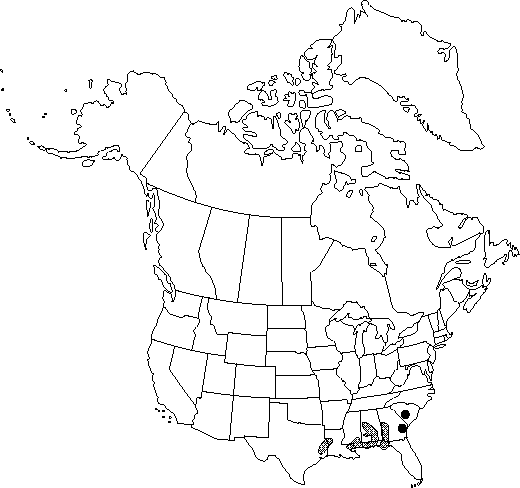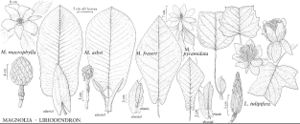Difference between revisions of "Magnolia pyramidata"
Travels Carolina, 408. 1791.
FNA>Volume Importer |
FNA>Volume Importer |
||
| Line 17: | Line 17: | ||
|basionyms= | |basionyms= | ||
|synonyms={{Treatment/ID/Synonym | |synonyms={{Treatment/ID/Synonym | ||
| − | |name= | + | |name=Magnolia auriculata var. pyramidata |
|authority=(W.Bartram) Nuttall | |authority=(W.Bartram) Nuttall | ||
| − | }}{{Treatment/ID/Synonym | + | }} {{Treatment/ID/Synonym |
| − | |name= | + | |name=Magnolia fraseri subsp. pyramidata |
|authority=(W.Bartram) E. Murray | |authority=(W.Bartram) E. Murray | ||
| − | }}{{Treatment/ID/Synonym | + | }} {{Treatment/ID/Synonym |
| − | |name= | + | |name=Magnolia fraseri var. pyramidata |
|authority=(W.Bartram) Pampanini | |authority=(W.Bartram) Pampanini | ||
| − | }}{{Treatment/ID/Synonym | + | }} {{Treatment/ID/Synonym |
| − | |name= | + | |name=Magnolia macrophylla var. pyramidata |
|authority=Nuttall | |authority=Nuttall | ||
}} | }} | ||
| Line 43: | Line 43: | ||
|elevation=0-120m | |elevation=0-120m | ||
|distribution=Ala.;Fla.;Ga.;La.;Miss.;S.C.;Tex. | |distribution=Ala.;Fla.;Ga.;La.;Miss.;S.C.;Tex. | ||
| − | |discussion=<p>Confined largely to the coastal plain, Magnolia pyramidata differs from the allopatric M. fraseri in being a smaller tree with a narrower, pyramidal habit; M. pyramidata is very local and nowhere abundant. Morphologically, M. pyramidata differs from M. fraseri in the pandurate leaf blades, smaller flowers and stipules, fewer stamens and pistils, and smaller follicetums. Magnolia pyramidata is occasionally cultivated, but it is less hardy than M. fraseri.</p><!-- | + | |discussion=<p>Confined largely to the coastal plain, <i>Magnolia pyramidata</i> differs from the allopatric <i>M. fraseri</i> in being a smaller tree with a narrower, pyramidal habit; <i>M. pyramidata</i> is very local and nowhere abundant. Morphologically, <i>M. pyramidata</i> differs from <i>M. fraseri</i> in the pandurate leaf blades, smaller flowers and stipules, fewer stamens and pistils, and smaller follicetums. <i>Magnolia pyramidata</i> is occasionally cultivated, but it is less hardy than <i>M. fraseri</i>.</p><!-- |
| − | --><p>The largest known tree of Magnolia pyramidata, 11.9m in height with a trunk diameter of 69 cm, is recorded from Newton County, Texas (American Forestry Association 1994).</p> | + | --><p>The largest known tree of <i>Magnolia pyramidata</i>, 11.9m in height with a trunk diameter of 69 cm, is recorded from Newton County, Texas (American Forestry Association 1994).</p> |
|tables= | |tables= | ||
|references= | |references= | ||
| Line 57: | Line 57: | ||
|rank=species | |rank=species | ||
|parent rank=genus | |parent rank=genus | ||
| − | |synonyms= | + | |synonyms=Magnolia auriculata var. pyramidata;Magnolia fraseri subsp. pyramidata;Magnolia fraseri var. pyramidata;Magnolia macrophylla var. pyramidata |
|basionyms= | |basionyms= | ||
|family=Magnoliaceae | |family=Magnoliaceae | ||
| Line 68: | Line 68: | ||
|publication year=1791 | |publication year=1791 | ||
|special status=Endemic;Selected by author to be illustrated | |special status=Endemic;Selected by author to be illustrated | ||
| − | |source xml=https://jpend@bitbucket.org/aafc-mbb/fna-data-curation.git/src/ | + | |source xml=https://jpend@bitbucket.org/aafc-mbb/fna-data-curation.git/src/8f726806613d60c220dc4493de13607dd3150896/coarse_grained_fna_xml/V3/V3_849.xml |
|genus=Magnolia | |genus=Magnolia | ||
|species=Magnolia pyramidata | |species=Magnolia pyramidata | ||
Revision as of 17:20, 18 September 2019
Trees, deciduous, single-trunked, to 11.9 m. Bark gray, smooth. Pith homogeneous. Twigs and foliar buds glabrous. Leaves crowded in terminal whorl-like clusters; stipules 5.4-7 × 2.5-3 cm, abaxially glandular. Leaf blade predominantly pandurate to broadly rhombic-spatulate, broadest above middle, abruptly tapering to base, 18-25(-30) × 7.8-14 cm, base deeply cordate to auriculate, or somewhat truncate, apex acute to short-acuminate; surfaces abaxially glaucous, glabrous, adaxially dull deep green. Flowers fragrant, 12-18 cm across; spathaceous bracts 2, abaxially glandular; tepals creamy white; stamens 83-137(-150), 4.5-8(-10.5) mm; filaments white; pistils 36-60. Follicetums ellipsoid, 4-6 × 2.5-3.5 cm, glabrous; follicles recurved, short-beaked, glabrous. Seeds lenticular, 7-8 mm, aril red. 2n=38.
Phenology: Flowering spring.
Habitat: Rich woods and river bluffs, mostly coastal plain, sometimes lower piedmont
Elevation: 0-120m
Distribution

Ala., Fla., Ga., La., Miss., S.C., Tex.
Discussion
Confined largely to the coastal plain, Magnolia pyramidata differs from the allopatric M. fraseri in being a smaller tree with a narrower, pyramidal habit; M. pyramidata is very local and nowhere abundant. Morphologically, M. pyramidata differs from M. fraseri in the pandurate leaf blades, smaller flowers and stipules, fewer stamens and pistils, and smaller follicetums. Magnolia pyramidata is occasionally cultivated, but it is less hardy than M. fraseri.
The largest known tree of Magnolia pyramidata, 11.9m in height with a trunk diameter of 69 cm, is recorded from Newton County, Texas (American Forestry Association 1994).
Selected References
None.
